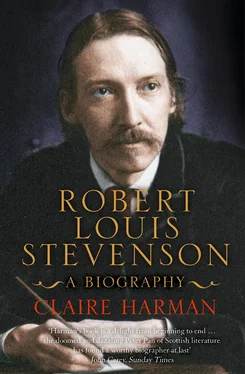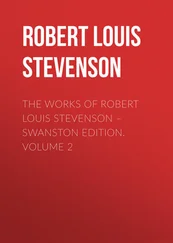Dread of judgement, midnight coffee and a predisposition to overheated dreaming and daydreaming made much of the sick little boy’s life a misery. He speaks of fevers that seemed to make the room swell and shrink, and ‘terrible long nights, that I lay awake, troubled continually with a hacking, exhausting cough, and praying for sleep or morning from the bottom of my shaken little body’. 31 He had a recurring nightmare of standing before the Great White Throne and being asked to recite some form of words, on which salvation or damnation depended; ‘his tongue stuck, his memory was blank, hell gaped for him’, 32 for the idea of eternal punishment had been ‘seared’, as he said, into his infant consciousness. When his night-horrors were particularly bad, Cummy would call for Thomas Stevenson, who would try to calm his son by sitting by the bed, or outside the bedroom door, feigning conversations with imaginary coachmen or inn-keepers. But, as the adult Louis recalled, ‘it was long, after one of these paroxysms, before I could bear to be left alone’. 33
Though in time the severity of his nightmares lessened, Stevenson continued to dream vividly and with disturbing conviction of reality, so that he was unable to distinguish whether his conscious or subconscious was in control. By the time he was a student his dreams produced the impression in him, nightmarish in itself, of leading a double life, at which point he began to fear for his reason. He learned in time to control his night-terrors, more or less (partly by the use of drugs), but if he hadn’t been terrified by hellfire rantings as a child, this habit of feverish dreaming and neurotic invention, that was to prove important to his writing, might possibly never have set in.
Stevenson avoided much reference in his published works to his ‘Covenanting childhood’, but left some strong words about it in manuscript (some of which were published in posthumous collections or used by his first biographer). There is a controlled savagery in these fragments about the adults who infected his young mind with ‘high-strung religious ecstasies and terrors’:
I would not only lie awake to weep for Jesus, which I have done many a time, but I would fear to trust myself to slumber lest I was not accepted and should slip, ere I awoke, into eternal ruin. I remember repeatedly [ … ] waking from a dream of Hell, clinging to the horizontal bar of the bed, with my knees and chin together, my soul shaken, my body convulsed with agony. It is not a pleasant subject. I piped and snivelled over the Bible, with an earnestness that had been talked into me. I would say nothing without adding ‘If I am spared,’ as though to disarm fate by a show of submission; and some of this feeling still remains upon me in my thirtieth year. 34
Of the ‘morbid devotees’ whose works were his constant diet, the adult Stevenson had this to say: ‘for a child, their utterances are truly poisonous. The life of Brainerd, for instance, my mother had the sense to forbid, when we [he and Cummy] were some way through it. God help the poor little hearts who are thus early plunged among the breakers of the spirit!’ 35
He makes it – for politeness’ sake – sound as if he was not one of those ‘poor little hearts’ himself, but the accusation of negligence against his parents and Cummy is unmistakable – especially against his mother for knowing better than Cummy, but being inattentive. Colvin’s description of Margaret Stevenson as ‘shutting her eyes to troubles’ seems pertinent here. The child’s precocious utterances, recorded faithfully in her diary notes, clearly struck the young mother as amusing and a source of pride, but to less sentimental readers they brim with complex fears. Little Lou worried constantly about the quality and quantity of his prayers, whether his family were good or bad in the Lord’s eyes, and whether he would be sufficiently adept at harp-playing during an eternity in heaven – and all this before the age of six. Adding to his discomfort was a strong rational streak and a quick intellect. His mother relates that when she told him of ‘the naughty woman pouring the ointment upon Christ’ he asked why God had made the woman so naughty, 36 and, hearing it confirmed that Christ had died to save him, concluded, ‘Well, then, doesn’t that look very much as if I were saved already?’ 37 These exchanges, engaging so adroitly with Calvinist theology, were not intended as cute additions to the Baby Album. The child must have been puzzled why they only elicited fond smiles.
In the years following Stevenson’s death, a minor cult grew up around the figure of his old nurse, fuelled mostly by his emotional dedication to her of A Child’s Garden of Verses , and a passage in his fragmentary memoir in which Cummy is singled out for her tender care of him when he was sick:
She was more patient than I can suppose of an angel; hours together she would help console me in my paroxysms; and I remember with particular distinctness, how she would lift me out of bed, and take me, rolled in blankets, to the window, whence I might look forth into the blue night starred with street-lamps, and see where the gas still burned behind the windows of other sickrooms. 38
But in all honesty, it hardly constitutes excess of attention or devotion to attend to a chronically sick child at night. ‘My second mother [ … ] angel of my infant life’; the epithets are cloyingly excessive, and one can’t help wondering if Stevenson’s retrospective praise of his nurse was a desperate attempt to accentuate the positive. His fond memories of his father soothing him with nonsense-stories are also in the context of the child on the other side of the door being too terrified to sleep. And the same Cummy who was ready to calm the child with cuddles and blankets was just as likely to wake him up and assault him with prayers. It was, to say the least, a confusing world.
The boy learned to read quite late (aged six), but was lazy about reading on his own and preferred to get Cummy to do it for him. He liked to be attended to as much as possible, especially by women. He had been composing his own stories some time before this, using his mother and aunt Jane Balfour as amanuenses, and his first recorded work was a history of Moses, which won him the prize of ‘The Happy Sunday Book of Painted Pictures’ in an informal competition among the cousins. The text is illustrated with some wonderful drawings by Lewis of the Israelites, all wearing mid-Victorian chimneypot hats, with pipes in their mouths, gathering in the manna or crossing the Red Sea. 39 He was good at drawing, in a speedy, impressionistic style: one blotchy ink picture of ‘A steamer bound for Londonderry’ has written on it in Thomas Stevenson’s hand: ‘Note. This steamer may be bound for Londonderry but I fear she will never reach it.’ 40
Religion entered everything and dominated play; when he was aged two and a half, Lou’s favourite game was ‘making a church’, which he did by putting a chair and stool together to form a pulpit and conducting his own solitary services in the character of both minister and congregation. At ‘an astoundingly tender age’ 41 he voiced strong antipathy to a theological iconoclast then attending the Edinburgh Kirk assembly. His sayings, many of them parroted from his parents or nurse (such as Cummy’s constant refrain of ‘If I’m spared’), were noted and preserved by his mother with the utmost care. At home, this little ‘dictator’ strove to be the centre of attention, and he later remembered his young self unflatteringly: ‘I was as much an egotist as I have ever been; I had a feverish desire of consideration.’ 42 To other children he was a bit of a liability; being an only child, he didn’t know how to handle rivals and expected to dominate play. As so often with children who insist on taking the lead, he had a markedly sadistic streak too, devising a ritual involving whacks on the hand with a cane when he and his cousins were bartering items for their ‘museums’. If the ‘buyer’ flinched during the transaction, the whole procedure had to start again. 43
Читать дальше












